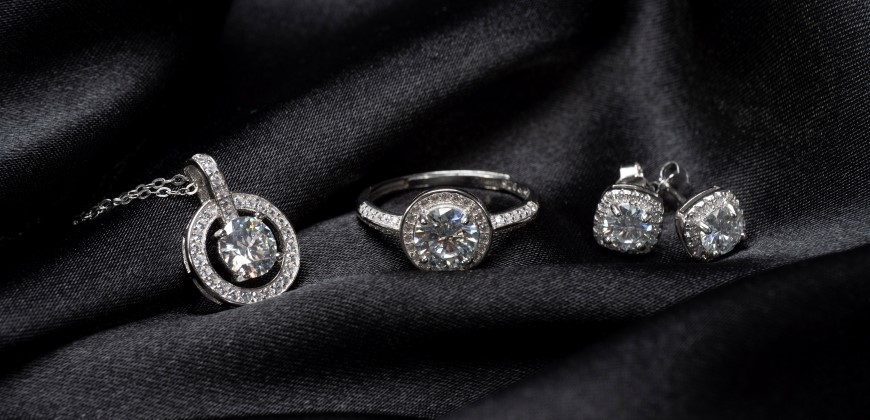
When it comes to jewelry, the pieces you love don’t always carry a high price tag. But those that do could be the ones we would classify as “fine” jewelry. Fine jewelry is made of precious metals like gold, silver or platinum. Fine jewelry also typically has genuine gemstones rather than simulated gemstones. Genuine gemstones are defined as diamonds, rubies, emeralds, and sapphires.
Fine jewelry precious metals will contain something called a “hallmark,” which is an indication or stamp on the precious metal telling you the characteristics of the metal itself. For instance, real gold may be stamped with 14k, 18k or a three-digit number indicating the percentage of real gold it contains. For instance, if gold is stamped with “750,” it indicates that it is 75% gold (the hallmark of 18k gold). If it’s stamped with 583, it indicates that it contains 58.3% gold (the hallmark of 14k gold). Platinum may have a stamp of “PLAT,” “PLATINUM” or even “950.” Sterling silver has many hallmarks, including 925 (the most standard hallmark), SILVER, SS or STERLING.
Fine jewelry is expertly crafted, and not typically mass-produced. It is much more durable than demi-fine or fashion jewelry. Fine jewelry can be timeless.
What is demi-fine jewelry?
Demi fine jewelry fills the gap between fine jewelry and fashion jewelry. It still may utilize some precious metals or even some genuine gemstones, but likely will not use both. It aims to fill a price point gap by providing look-alike options that are simply more affordable for most. Considering that a platinum ring with diamonds could cost thousands of dollars, a similar-looking ring made of sterling silver and moissanite or white sapphires could cost less and is a perfect example of demi-fine jewelry. Jewelers have found very creative ways to provide the fine jewelry look by mixing metals and unique gemstones in a way that makes it much more affordable.
What is a fine jewelry purveyor?
A fine jewelry purveyor is someone whose profession is to source and purchase high-quality jewelry and materials. Very trusted in the industry, fine jewelry purveyors are the creme de la creme of jewelers . It is the job of a fine jewelry purveyor to source fine diamonds, rare gemstones and the purest precious metals—and then sell these treasures to other jewelers who sell them locally.
What's the difference between fine jewelry and fashion jewelry?
Now that you know that fine jewelry is typically made of precious metals and genuine gemstones, it’s typically in the higher cost range for jewelry. Fashion jewelry, on the other hand, fulfills a much different need than that of timeless, classic fine jewelry. Fashion jewelry is made of much cheaper, non-precious metals and not genuine, look-a-like gems in a mass-produced way, so it is the most affordable way to add bling to your jewelry box. Fashion jewelry can be made in sterling silver or plated gold, but most often is made of copper, brass or even aluminum to keep the costs down. Fashion jewelry, often called “costume” jewelry, is usually not made to last, but to take advantage of trends as they occur in the fashion world (hence the name). Chunky beads or specific-colored necklaces or earrings can be made in no time when they are mass-produced. They are then distributed to savvy, trend-following consumers across the country (or globe!) quickly to take advantage of fast-moving trends. Fashion jewelry is usually replaced over time as these trends come and go. The non-precious metals and inexpensive, imposter gemstones will wear down and may even fall apart over time as they are simply not durable enough to last very long without impeccable care (and by then, the trend will have passed!).
What’s the difference between fine jewelry and high jewelry?
High jewelry is the pinnacle of fine jewelry, exhibiting the most expensive gemstones and precious metals. But metals and gemstones alone would not qualify fine jewelry for high jewelry. High jewelry’s trademark is the very expression of the jewelry piece itself. It is expertly crafted in distinctive designs by designer brands. High jewelry designers focus on limited-edition pieces or one-of-a-kind pieces that are beautiful masterpieces and works of art.
Why you should know the difference
It’s important to know the difference between fashion, demi-fine, fine and high jewelry when you’re shopping. Reputable jewelers will ensure that shoppers know exactly what they are purchasing. Be sure to look for and ask about the materials in any jewelry you have your eye on under the glass case . A reputable jeweler will help you find the hallmarks and may provide a certificate of authenticity. This can help you ensure that the price tag matches the quality of the piece you are buying.
While fine and high jewelry differs greatly from fashion jewelry, all perform the same basic function for wearers: to provide joy while wearing it and reflect your personality! Fashion jewelry is the most affordable and therefore can allow you to purchase more of it due to its low price point, but you will also replace it more often as trends and your tastes change.
But for all fine and high jewelry you do invest in, be sure to purchase jewelry insurance to cover theft, damage, loss and more! Jewelry may be covered under renters and homeowners insurance policies. But that coverage is not usually enough to cover the cost, and even a jewelry-specific rider added to your homeowner's policy has its limits. Insuring your jewelry with a standalone policy protects your home insurance from the effects of a claim. Check your rate today!
